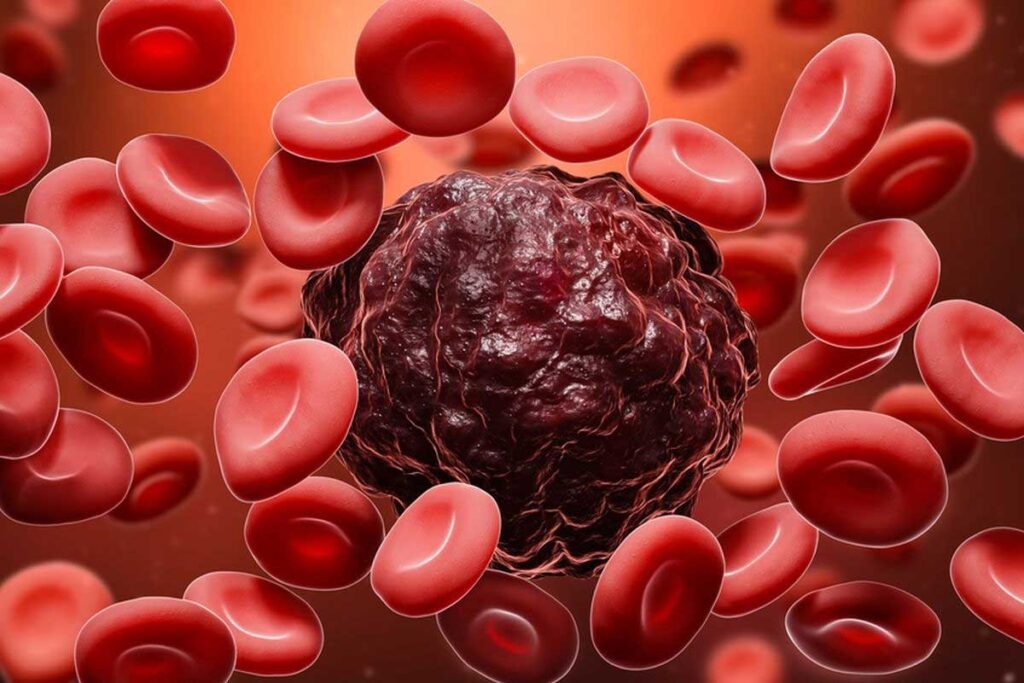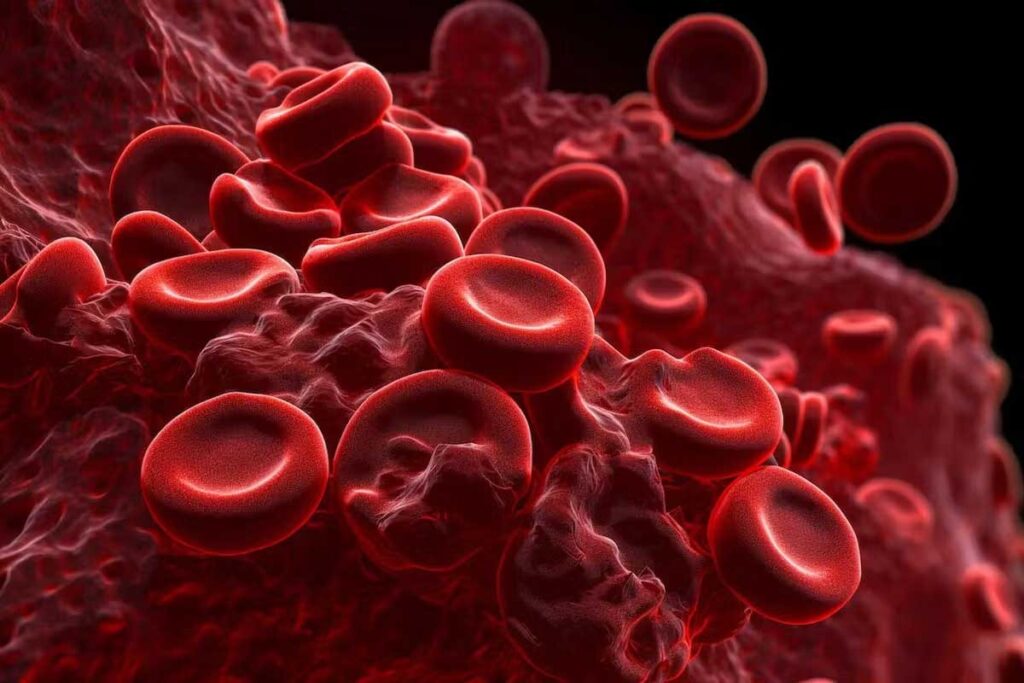Last Updated on October 21, 2025 by mcelik

Feeling tired, bleeding, or getting sick often could mean you have a serious blood disorder. Spotting these signs early can lead to better treatment and results.
Liv Hospital is here to help you understand the warning signs of rare blood conditions. Look out for signs like tiredness, weakness, bruises without reason, and shortness of breath. Catching these early is key to managing your health.

It’s important to know about blood disorders to catch them early and manage them well. These conditions affect how blood cells are made, work, and stay healthy.
A blood disorder happens when blood cells don’t work right. This can be because of genes, the environment, or both. Rare genetic blood disorders like Sickle Cell Disease and Thalassemia are passed down and can really change someone’s life.
Finding blood disorders early is key to treating them well. Many can be managed with the right treatment, making life better for the patient. For example, catching Von Willebrand disease and Hemophilia early can stop serious problems.
Early detection is very important. It lets doctors start treatments that can lessen the disorder’s effects.
There are many things that can make someone more likely to get a blood disorder. Being born with certain genes can increase the risk of getting Sickle Cell Disease or Thalassemia. Being around certain chemicals or radiation can also cause some blood disorders.

It’s key to know the signs of blood diseases early. Blood disorders show up in many ways. So, it’s important to watch for these symptoms:
Fatigue and weakness are common signs. They happen when you don’t have enough red blood cells or hemoglobin. This makes it hard for your body to get enough oxygen. If you’re always tired, see a doctor.
Unexplained bruising or purpura can mean a blood disorder. This is often due to problems with platelets or clotting factors. If you get bruises without reason, check it out.
Prolonged bleeding after small cuts or injuries is a warning sign. It means your body might not be clotting right. This could be a sign of a bleeding disorder. Learn more about it here.
Shortness of breath can be a sign of anemia or other blood issues. If you find it hard to breathe, even when you’re not doing anything, get help.
There are 11 more symptoms to watch for:
Knowing these symptoms can help catch blood disorders early. If you notice any, see a doctor right away.
It’s important to know the signs of bleeding-related issues early. These signs can show up in many ways. Knowing what to look for can help spot blood disorders early.
Easy bruising and small spots on the skin are signs of bleeding problems. These happen when blood can’t clot right or when there are not enough platelets. If you see a lot of bruising or spots, see a doctor.
Bleeding a long time from small cuts can mean a bleeding disorder. Conditions like hemophilia or von Willebrand disease can cause this. If bleeding doesn’t stop, it’s a sign to see a doctor.
Heavy bleeding during periods is a big sign of a bleeding disorder. If you’re bleeding a lot, passing big clots, or need to change pads often, get medical help.
Having nosebleeds a lot can mean a bleeding disorder or another health issue. While some nosebleeds are normal, too many mean you should see a doctor.
| Bleeding-Related Symptom | Possible Indication |
| Easy Bruising | Low platelet count or clotting disorder |
| Petechiae | Low platelet count or bleeding disorder |
| Prolonged Bleeding | Hemophilia or von Willebrand disease |
| Heavy Menstrual Bleeding | Bleeding disorder or hormonal imbalance |
| Frequent Nosebleeds | Bleeding disorder or other underlying conditions |
Knowing these signs and getting medical help early can help manage blood disorders better.
Immune system indicators can show if you have a blood disorder. They might seem unrelated at first. The immune system fights infections and diseases. When it doesn’t work right, it could mean you have a rare blood condition.
Getting sick a lot can mean your immune system is not working well. This might be because of a blood disorder. When you can’t fight off infections, it could be a sign of a problem with your blood cells.
Wounds that take a long time to heal might be a sign of a blood disorder. Healing needs cells and factors in your blood. If your blood cells or clotting factors are off, healing can take longer.
Swollen lymph nodes can be a sign of a blood disorder. Lymph nodes help fight off germs and support your immune system. Swelling means your immune system might be reacting strangely or there’s a blood cell disorder.
The table below shows important signs that might mean you have a blood disorder:
| Indicator | Description | Potential Blood Disorder Association |
| Recurrent Infections | Frequent occurrence of infections | Immunodeficiency disorders, leukemia |
| Slow Healing of Wounds | Prolonged time for wounds to heal | Clotting disorders, anemia |
| Abnormal Lymph Node Swelling | Swelling of lymph nodes | Lymphoma, leukemia |
It’s important to know these signs for early detection and treatment of symptoms of blood disorders in adults. If you or someone you know has these symptoms, see a doctor right away.
Certain symptoms can point to rare blood disorders that need quick medical help. Spotting these signs early can greatly improve treatment results and patient health.
Night sweats are common in many health issues, including rare blood disorders. When night sweats keep happening and you also have fever or weight loss, it could mean a serious problem. For example, in lymphoma, night sweats can show the disease is getting worse or active.
Unexplained weight loss is a warning sign for many health problems, including rare blood disorders. Weight loss that happens fast without diet or exercise changes is a big red flag. In blood disorders, it might mean cancer or other diseases that mess with the body’s functions.
Bone and joint pain can be signs of rare blood disorders. For instance, in sickle cell disease, pain happens because of vaso-occlusive crises. It’s important to know why the pain is happening to manage it well.
Pain crises are a big deal in some rare blood disorders like sickle cell disease. These episodes are very painful and need quick medical help. The pain can vary a lot from person to person, so treatment plans need to be tailored.
| Symptom | Possible Rare Blood Disorder | Immediate Action Required |
| Persistent Night Sweats | Lymphoma, Leukemia | Yes, if accompanied by fever or weight loss |
| Unexplained Weight Loss | Cancers, Anemia | Yes, if significant and rapid |
| Bone and Joint Pain | Sickle Cell Disease, Leukemia | Yes, if severe or persistent |
| Pain Crises | Sickle Cell Disease | Yes, often requires hospitalization |
In conclusion, knowing the symptoms of rare blood disorders and getting medical help when needed is very important. Early detection and treatment are key to managing these conditions well.
It’s important to know about rare genetic blood disorders to catch them early. These conditions can be passed down in families and really affect someone’s life. They change how blood works and is made.
Sickle Cell Disease is a genetic issue that messes with hemoglobin. This makes red blood cells bend and break down. It causes anemia, infections, and pain episodes.
This disease is common in people of African descent but can affect others too. Symptoms can be different for everyone. Some people have mild issues, while others face pain crises and infections often. Early diagnosis and management are key to better living for those with it.
Thalassemia is a genetic disorder that affects hemoglobin production. It leads to anemia and other problems because of less hemoglobin. There are different types, each with its own severity.
Managing Thalassemia often means getting regular blood transfusions and iron chelation therapy. This helps deal with iron buildup. Genetic counseling is also vital, mainly for families with Thalassemia history.
Fanconi Anemia is a rare genetic disorder that causes bone marrow failure. This results in a lack of blood cells. It also raises the risk of cancers and birth defects.
Treatment for Fanconi Anemia might include bone marrow transplants, blood transfusions, and drugs to boost blood cell making. Monitoring for associated health issues is key for those with this condition.
Genetic testing is essential for diagnosing rare genetic blood disorders. It spots mutations linked to these conditions, leading to early action and planning for families.
A family history of genetic blood disorders is a big risk factor. People with such a history should think about genetic counseling and testing. This helps them understand their risk and the risk to their kids.
It’s important to know about rare blood disorders to catch them early. These conditions can really affect a person’s life. We’ll look at some rare blood disorders, their symptoms, and how to treat them.
Hemophilia is a genetic disorder that makes it hard for blood to clot. This leads to long or sudden bleeding, often in joints or muscles. There are two main types: Hemophilia A and Hemophilia B, each caused by a missing clotting factor.
Treatment for Hemophilia usually involves giving the missing clotting factor. This helps the blood clot right. Regular treatments can stop bleeding and prevent damage.
Von Willebrand Disease (VWD) is a bleeding disorder caused by a problem with the von Willebrand factor. Symptoms range from mild to severe, like easy bruising and heavy periods. They can also include bleeding that doesn’t stop after an injury or surgery.
Managing VWD might include desmopressin to release VWF or VWF concentrates for severe cases. Knowing the type of VWD is key to finding the right treatment.
Paroxysmal Nocturnal Hemoglobinuria (PNH) is a rare disease that destroys red blood cells and can cause bone marrow failure and blood clots. Symptoms include fatigue, shortness of breath, and pain from blood clots.
Treatment for PNH has improved with new medicines that reduce hemolysis. Bone marrow transplantation is also an option for some.
There are many other rare blood disorders beyond Hemophilia, VWD, and PNH. Some examples include:
| Rare Blood Disorder | Key Characteristics | Common Symptoms |
| Hemophilia | Genetic disorder affecting blood clotting | Prolonged bleeding, joint pain |
| Von Willebrand Disease | Deficiency or mutation of VWF | Easy bruising, heavy menstrual bleeding |
| Paroxysmal Nocturnal Hemoglobinuria | Destruction of red blood cells, bone marrow failure | Fatigue, shortness of breath, abdominal pain |
It’s vital for healthcare providers to understand these rare blood disorders. Early detection and the right treatment can greatly improve a patient’s life.
Knowing when to get medical help for blood disorder symptoms is very important. Blood disorders can show up in many ways. It’s key to know the signs that mean you need to see a doctor right away.
Some symptoms mean you need to see a doctor fast. These include:
It’s very important to get medical help right away if you have any of these signs.
Some symptoms aren’t life-threatening but need to be seen by a doctor quickly. These include:
Seeing a doctor early can really help people with blood disorders.
| Symptom | Possible Indication | Action |
| Severe Anemia | Blood cell production disorder | Seek medical attention within 24 hours |
| Frequent Infections | Immune system dysfunction | Consult a doctor within a few days |
| Unexplained Bruising | Platelet disorder or clotting issue | Schedule an appointment with a hematologist |
When you go to the doctor for blood disorder symptoms, tell them everything you can. This includes:
“Accurate diagnosis and effective treatment of blood disorders rely heavily on the patient’s ability to communicate their symptoms and medical history clearly.”
Being informed and proactive helps ensure you get the right care for your condition.
Understanding how to diagnose blood disorders is key to early treatment. Accurate diagnosis is vital for managing symptoms and improving health outcomes.
A Complete Blood Count (CBC) is a basic test that shows important blood details. It checks red blood cells, white blood cells, and platelets. It helps spot issues like anemia, infections, and leukemia.
“A CBC is often the first step in diagnosing blood disorders, as it provides a broad overview of a patient’s blood health,” says a hematology expert. The test looks at hemoglobin levels, hematocrit, and white blood cell count. These are key for diagnosing anemia and infections.
For rare blood conditions, specialized testing is needed. Tests like flow cytometry and molecular testing are used. They help find specific cell types and genetic mutations.
A bone marrow biopsy takes a bone marrow sample for examination. It’s key for diagnosing leukemia, lymphoma, and myeloma. It shows the bone marrow’s health and disease extent.
“Bone marrow biopsy is a definitive diagnostic tool that provides critical information about the health of the bone marrow and the presence of any malignant cells.”
Genetic testing is vital for inherited blood disorders. DNA sequencing can find genetic mutations in sickle cell disease and thalassemia. This info is important for family planning and risk prediction.
| Diagnostic Test | Information Provided |
| Complete Blood Count (CBC) | Overview of blood components, detects anemia, infection, and leukemia |
| Specialized Testing | Confirms diagnosis of rare blood conditions through flow cytometry and molecular testing |
| Bone Marrow Biopsy | Detailed information about bone marrow health and disease progression |
| Genetic Testing | Identifies genetic mutations responsible for inherited blood disorders |
It’s important for patients and doctors to know about blood disorder treatments. The right treatment depends on the disorder, its severity, and the patient’s health.
Medicines help manage symptoms of blood disorders. For example, anticoagulants stop blood clots in deep vein thrombosis. Immunosuppressive drugs help autoimmune hemolytic anemia by reducing the immune system’s attack on red blood cells.
Blood transfusions treat many blood disorders, like anemia and bleeding disorders. They add blood or blood parts to replace or supplement the patient’s blood. Red blood cell transfusions boost oxygen delivery, while platelet transfusions prevent or treat bleeding.
Bone marrow transplantation is a cure for some blood disorders, like leukemia and aplastic anemia. It replaces the patient’s diseased bone marrow with healthy stem cells from a donor.
New treatments for blood disorders are being researched. Gene therapy aims to fix genetic defects. Clinical trials test these new treatments for safety and effectiveness.
As medical science grows, so does the hope for blood disorder treatments. This brings new hope to patients and their families.
Early detection is key to managing blood disorders well. Spotting the signs of rare blood disorders can greatly improve treatment results. Knowing the warning signs helps people get medical help fast, which can stop serious problems.
Symptoms like unexplained bruises, long bleeding times, and feeling very tired can mean there’s a serious issue. Knowing these signs and what they mean can lead to quick diagnosis and treatment.
Rare blood disorders, like sickle cell disease and hemophilia, need special care. Finding these conditions early through tests can lead to better management. This improves life quality for those affected.
Learning about blood disorder symptoms and the need for early detection is important. It helps people stay healthy and get the right medical care when they need it.
Symptoms include fatigue, weakness, and unexplained bruising. Prolonged bleeding and shortness of breath are also common. Other signs are recurrent infections, slow healing of wounds, and abnormal lymph node swelling.
A blood disorder affects the blood’s normal function. It can involve red and white blood cells, platelets, and plasma. Causes include genetic mutations and environmental factors.
Diagnosis involves a physical exam, medical history, and lab tests. Tests include Complete Blood Count and genetic testing. Sometimes, a bone marrow biopsy is needed.
Treatment depends on the disorder’s type and severity. Options include medication, blood transfusions, and bone marrow transplantation. Gene therapy and clinical trials are also available.
Seek medical help for severe bleeding, breathing trouble, or persistent fatigue. Also, see a doctor for unexplained symptoms or a family history of blood disorders.
Early detection is key. It allows for timely treatment, improving outcomes and quality of life. Early recognition can prevent complications and long-term damage.
Rare disorders include Sickle Cell Disease, Thalassemia, and Fanconi Anemia. Hemophilia, Von Willebrand Disease, and Paroxysmal Nocturnal Hemoglobinuria are also rare. Each has unique symptoms and is diagnosed through clinical evaluation and lab tests.
Cure possibilities vary by disorder. Some, like certain anemias, can be managed well. Others, like Sickle Cell Disease, require ongoing care. Gene therapy research is ongoing.
Warning signs like easy bruising and prolonged bleeding suggest blood disorders. These include clotting disorders or platelet issues.
Genetic testing is vital for diagnosing rare genetic disorders. It identifies specific mutations. This guides treatment and informs about genetic risks to offspring
https://www.hematology.org/education/patients/bleeding-disorders
Subscribe to our e-newsletter to stay informed about the latest innovations in the world of health and exclusive offers!
WhatsApp us